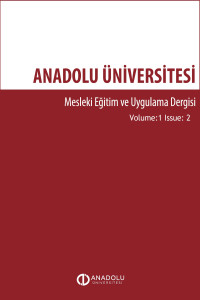Examining Mechatronics Associate Degree Programs with High Base Scores in the Perspective of University, City and Student Preferences
Abstract
Today, technological transformation processes such as Industry 4.0 and the Internet of Things (IoT) show a rapid development and effect the industry and many areas of our lives. There are very important technological developments in many fields, especially in robots, electric vehicles, unmanned aerial vehicles, autonomous systems, smart home applications and 3D printers. Technical workers with high technical knowledge and skills are needed for the development, installation, and operation of these systems. Vocational and technical education institutions, associate degree, undergraduate and graduate departments of universities contribute to the manpower trained in this field. Mechatronics discipline is one of the most important fields that can meet the required technical human resources. At this point, mechatronics associate degree programs in Turkey draw attention. In this study, mechatronics associate degree programs of state universities with a base score of 300 points above the Basic Proficiency Test (TYT) in 2022 and the universities with these programs were examined. Considering whether the universities are research universities and the 2022-2023 URAP rankings prepared by the Middle East Technical University Informatics Institute, their relationship with university preference priority was examined. The academic profile of the regular academicians who teach in the relevant programs has been researched. In the next stage, students' preference and placement data were analyzed using the YÖK atlas data for the year 2019-2021. The base scores of the determined programs and the changes in the rankings of these programs were examined. The quotas of the programs and the initial placement rates in these quotas were investigated. The preference of the program in terms of gender was investigated by looking at the gender distribution of the students placed in the programs. The effects of universities and cities on preferences were examined by examining how many candidates preferred the programs in total and the number of candidates per quota. The situation of vocational high schools was revealed by looking at the placement rates of students coming from vocational high schools and different high school types by investigating the number of students whose Secondary Education Achievement Scores (OÖBP) were calculated as normal and additional scores. By looking at the TYT exam ranking of the person who was placed last in the programs, the ranking differences between the candidates placed in the schools were examined.
Keywords
Mechatronics Associate Degree Education University Profile University Preference Preference Analysis
References
- Acar, M. (1997). Mechatronics challenge for the higher education world. IEEE Transactions on Components, Packaging, and Manufacturing Technology: Part C, 20(1), 14-20.
- Acar, M. ve Parkin, R. M. (1996). Engineering education for mechatronics. IEEE Transactions on Industrial Electronics, 43(1), 106-112.
- Akpinar, B. (2006). Mechatronics education in Turkey. Mechatronics, 16(3-4), 185-192.
YÜKSEK TABAN PUANLI MEKATRONİK ÖN LİSANS PROGRAMLARININ: ÜNİVERSİTE, ŞEHİR VE ÖĞRENCİ TERCİHLERİ PERSPEKTİFİNDE İNCELENMESİ
Abstract
Günümüzde Endüstri 4.0 ve Nesnelerin İnterneti (IoT) gibi teknolojik dönüşüm süreçleri hızlı bir gelişim göstermekte, endüstriyi ve hayatımızın birçok alanı etkilemektedir. Robotlar, elektrikli araçlar, insansız hava araçları, otonom sistemler, akıllı ev uygulamaları ve 3D yazıcılar başta olmak üzere birçok alanda çok önemli teknolojik gelişmeler yaşanmaktadır. Bu sistemlerin geliştirilmesi, kurulumu, işletilmesi için teknik bilgi altyapısı ve becerileri yüksek teknik çalışanlara ihtiyaç duyulmaktadır. Bu alanda yetişmiş insan gücüne mesleki ve teknik eğitim kurumları, üniversitelerin ön lisans, lisans ve lisansüstü bölümleri katkı sunmaktadır. Mekatronik disiplini ihtiyaç duyulan teknik insan kaynağını karşılayabilecek en önemli alanların başında gelmektedir. Bu noktada, Türkiye eğitim vermekte olan mekatronik ön lisans programları dikkat çekmektedir. Bu çalışmada, 2022 yılında Temel Yeterlilik Testi (TYT)’den 300 puan üzerinde taban puanı olan, en yüksek taban puanlı devlet üniversitelerinin mekatronik ön lisans programları ve bu programların bulundukları üniversiteler incelenmiştir. Üniversitelerin araştırma üniversitesi olup olmadığı ve Ortadoğu Teknik Üniversitesi Enformatik Enstitüsünün hazırladığı 2022-2023 URAP sıralamaları dikkate alınarak üniversite tercih önceliği ile ilişkisi incelenmiştir. İlgili programlarda ders veren kadrolu akademisyenlerin akademik profili araştırılmıştır. Sonraki aşamada 2019-2021 yılı YÖK atlas verileri kullanılarak öğrencilerin tercih ve yerleştirme verileri analiz edilmiştir. Belirlenen programların taban puanları ve bu programların sıralamalarındaki değişimler incelenmiştir. Programların kontenjanları ve bu kontenjanlara ilk yerleştirme oranları araştırılmıştır. Programlara yerleşen öğrencilerin kız ve erkek cinsiyet dağılımlarına bakılarak programın cinsiyetler açısından tercih edilirliği araştırılmıştır. Programların toplamda kaç aday tarafından tercih edildiği ve kontenjan başına tercih eden aday sayısı incelenerek üniversite ve şehirlerin tercihler üzerindeki etkisi incelenmiştir. Orta Öğretim Başarı Puanları (OÖBP) normal ve ek puanlı olarak hesaplanan öğrenci sayıları araştırılarak meslek liseleri ve farklı lise türlerinden gelen öğrencilerin yerleştirme oranlarına bakılarak meslek liselerinin durumu ortaya konuşmuştur. Programlara son yerleşen kişinin TYT sınav sıralamasına bakılarak okullara yerleşen adaylar arasındaki sıralama farkları incelenmiştir.
References
- Acar, M. (1997). Mechatronics challenge for the higher education world. IEEE Transactions on Components, Packaging, and Manufacturing Technology: Part C, 20(1), 14-20.
- Acar, M. ve Parkin, R. M. (1996). Engineering education for mechatronics. IEEE Transactions on Industrial Electronics, 43(1), 106-112.
- Akpinar, B. (2006). Mechatronics education in Turkey. Mechatronics, 16(3-4), 185-192.
Details
| Primary Language | Turkish |
|---|---|
| Journal Section | Research Articles |
| Authors | |
| Early Pub Date | December 30, 2022 |
| Publication Date | December 30, 2022 |
| Submission Date | November 19, 2022 |
| Published in Issue | Year 2022 Volume: 1 Issue: 2 |
Cite
Articles Published in Journal of Anadolu University Vocational Education and Practice (JAUVEP) are Licensed under a Creative Commons Attribution-NonCommercial 4.0 International License (CC BY-NC 4.0).
Journal of Anadolu University Vocational Education and Practice (JAUVEP) provides immediate open-access to its content, reflecting its conviction in advancing global knowledge exchange. The opinions presented in the articles are the sole responsibility of their respective authors and do not present the views or opinions of Journal of Anadolu University Vocational Education and Practice (JAUVEP).

